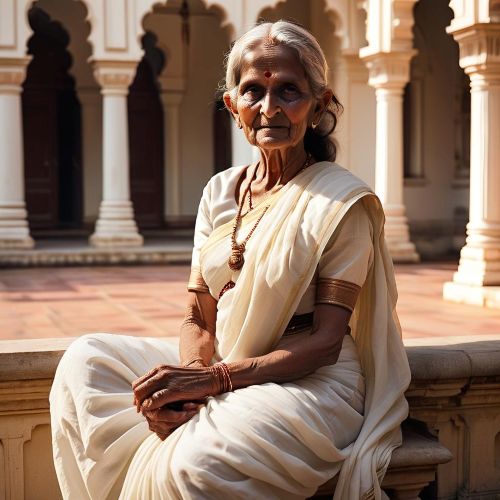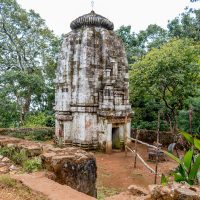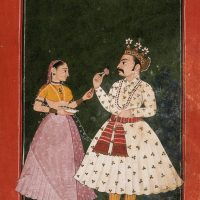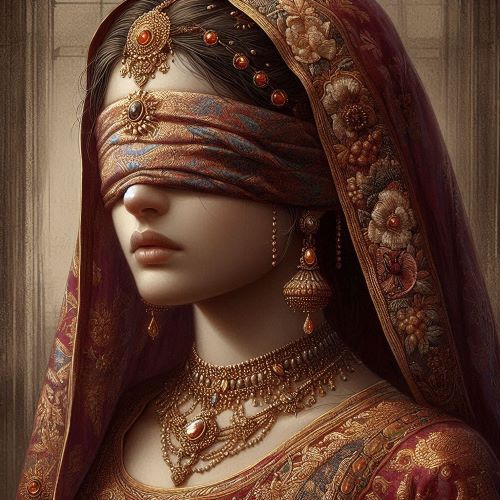
Kunti : The Queen Mother
Listen
Kunti
Introduction
Kunti, also known by her birth name Pritha, stands as one of the most profound and influential women in Indian mythology. As the mother of the Pandavas and a pivotal character in the Mahabharata, Kunti embodies strength, wisdom, and sacrifice. Her story begins with her birth to King Shurasena of the Yadava clan and her adoption by her uncle, King Kuntibhoja, which earned her the name “Kunti.” From her early years, her life was marked by divine encounters and moral challenges that shaped the destiny of one of the greatest epics ever told. Her tale is not just one of motherhood and devotion, but of resilience in the face of social judgment, personal guilt, and the heavy weight of dharma. Kunti’s presence in the Mahabharata bridges the mortal and divine worlds, making her both a symbol of feminine endurance and an enduring figure of philosophical reflection in Hindu thought.
Physical Traits
While ancient scriptures like the Mahabharata and the Puranas rarely dwell on detailed physical descriptions, Kunti is consistently portrayed as a woman of grace, dignity, and spiritual radiance. Her beauty is often implied rather than explicitly described, seen through the reverence and admiration she receives from sages and deities alike. Artists and storytellers across generations have imagined her with serene features, soft yet determined eyes, and an aura of compassion—an external manifestation of her inner strength and righteousness. Her original name, Pritha, is sometimes interpreted to symbolize “broadness” or “expansiveness,” reflecting her boundless compassion and nurturing nature. In essence, Kunti’s beauty lies not merely in her form but in her composure, intelligence, and unwavering adherence to moral principles, which make her a figure of timeless elegance and respect.
Family
Kunti’s family ties are deeply intertwined with the divine and royal bloodlines of ancient India. Born to King Shurasena and sister to Vasudeva—the father of Lord Krishna—she was raised by King Kuntibhoja after being adopted as his own daughter. This adoption brought her into prominence as a princess of the Kunti kingdom, giving her the name by which she is most widely known.
Her marriage to King Pandu of Hastinapura marked a turning point in her life. When Pandu was cursed to die if he ever engaged in physical relations with his wives, Kunti’s destiny shifted from being a queen to a bearer of divine progeny. She used a sacred mantra granted to her by Sage Durvasa to invoke gods and bear children. Through this boon, she gave birth to three of the five Pandavas: Yudhishthira (through the god Dharma), Bhima (through Vayu, the wind god), and Arjuna (through Indra, the king of the gods).
Before her marriage, however, Kunti had tested this mantra out of curiosity, invoking Surya, the sun god, which resulted in the birth of Karna. Fearing social stigma, she placed the infant in a river, where he was found and raised by a charioteer’s family. This act, though born of fear, haunted Kunti throughout her life and added a tragic dimension to her character. After Pandu’s death, she also took care of Madri’s twin sons, Nakula and Sahadeva, making her the maternal figure of all five Pandavas.
Her familial bond with Lord Krishna, her nephew, also played a crucial role in shaping the moral and spiritual backbone of the Pandavas during the Kurukshetra War. Kunti’s family relationships are complex, filled with love, sacrifice, and moral dilemmas that continue to captivate readers and thinkers to this day.
Other names
Kunti is known by several names that mark the various stages and identities of her life. Her birth name, Pritha, connects her to her Yadava lineage and her father, Shurasena. Upon being adopted by King Kuntibhoja, she became known as Kunti, a name that eventually overshadowed her birth name and became synonymous with her enduring legend.
In literary and devotional texts, she is also referred to as Kaunteya Mata (mother of the Kaunteyas, i.e., the sons of Kunti). Her sons, too, are often identified by their matronymic title, a rare acknowledgment of a mother’s prominence in ancient patriarchal tradition. Moreover, Kunti is one of the Panchakanyas—the five legendary women of Hindu tradition (Ahalya, Tara, Mandodari, Draupadi, and Kunti)—whose names are believed to bring purity when recited. Each of these women, though flawed and tested, represents spiritual virtue, moral endurance, and strength against adversity.
Powers and Abilities
Kunti’s divine power lay in the Atharva Veda mantra granted to her by Sage Durvasa. This sacred invocation enabled her to summon any god and bear a child through divine conception. With this mantra, she became a conduit between the mortal and celestial worlds, mothering children who embodied divine virtues and strength.
Yudhishthira, born of Dharma, represented righteousness and justice; Bhima, son of Vayu, symbolized strength and courage; and Arjuna, child of Indra, embodied valor and skill. Through Madri, who received the mantra from Kunti, the Ashwini twins were invoked, leading to the birth of Nakula and Sahadeva. Thus, Kunti’s gift ensured the continuation of Pandu’s lineage and the eventual rise of the Pandavas, the heroes of the Mahabharata.
Beyond her supernatural gift, Kunti’s mental and emotional strength were among her greatest abilities. She displayed remarkable resilience during Pandu’s exile, guided her sons through political crises, and maintained their moral compass during hardships. Her wisdom in diplomacy, her foresight during the Pandavas’ struggles, and her composure amid personal turmoil demonstrated not just spiritual power but human brilliance. Her life exemplifies how intellect, faith, and perseverance can triumph over suffering and uncertainty.
Modern Day Influence
Kunti’s legacy transcends the pages of the Mahabharata and continues to inspire scholars, artists, and feminists alike. Modern reinterpretations of her story explore her as a woman caught between divine duty and social expectations—a mother forced to make impossible choices in a patriarchal world.
Writers like Chitra Banerjee Divakaruni in The Palace of Illusions and Madhavi S. Mahadevan in The Kaunteyas reimagine Kunti’s voice, granting her the agency and introspection often denied in traditional tellings. Through these feminist perspectives, Kunti emerges not merely as a supporting figure but as a protagonist—intelligent, flawed, and deeply human.
In Indian television and cinema, Kunti has been portrayed as the epitome of maternal strength, moral fortitude, and silent suffering. Her dialogues and decisions—especially her confession to Karna before the war—remain some of the most emotionally charged moments in Indian mythology.
Academically, Kunti has become a case study for examining women’s roles in ancient literature and how mythic narratives reflect social norms. Her story is often compared to that of mythological mothers from other cultures, highlighting universal themes of sacrifice, shame, and divine motherhood.
Even in modern spirituality, the recitation of her name as one of the Panchakanya continues in rituals and prayers, symbolizing purification and divine protection. Kunti’s relevance endures because her story mirrors real human experiences—of guilt, love, endurance, and redemption.
Related Images
Source
Hiltebeitel, A. (2002). Kunti. In Encyclopedia of Hinduism.
Biardeau, M. (1995). The Mythology of Kunti. Journal of Indian Mythological Studies, 13(2), 45-62.
The Indian Mythology. (2012, June 20). Kunti – The Indian Mythology. Retrieved from https://theindianmythology.wordpress.com/2012/06/21/kunti/
Vemsani, L. (2013). The Power of Women in the Mahabharata: A Study of Kunti’s Role. India: Mythological Press.
Wisdom Library. (2025, June 5). Kunti. Retrieved from https://www.wisdomlib.org/definition/kunti
Journal of the Department of Museology. (2023). Kunti’s Symbolism and Cultural Impact. Calcutta University Press.
Payyanur, V. (2024, December 28). Enigmas in the life of Kunti – Part 1. VenuPayyanur.com.
IJFMR. (2023). Kunti from The Great Epic Mahabharata. International Journal of Future Modern Research, 6(2), 134-145.
Frequently Asked Questions
What is lorem Ipsum?
I am text block. Click edit button to change this text. Lorem ipsum dolor sit amet, consectetur adipiscing elit. Ut elit tellus, luctus nec ullamcorper mattis, pulvinar dapibus leo.
What is lorem Ipsum?
I am text block. Click edit button to change this text. Lorem ipsum dolor sit amet, consectetur adipiscing elit. Ut elit tellus, luctus nec ullamcorper mattis, pulvinar dapibus leo.
What is lorem Ipsum?
I am text block. Click edit button to change this text. Lorem ipsum dolor sit amet, consectetur adipiscing elit. Ut elit tellus, luctus nec ullamcorper mattis, pulvinar dapibus leo.
What is lorem Ipsum?
I am text block. Click edit button to change this text. Lorem ipsum dolor sit amet, consectetur adipiscing elit. Ut elit tellus, luctus nec ullamcorper mattis, pulvinar dapibus leo.
What is lorem Ipsum?
I am text block. Click edit button to change this text. Lorem ipsum dolor sit amet, consectetur adipiscing elit. Ut elit tellus, luctus nec ullamcorper mattis, pulvinar dapibus leo.













